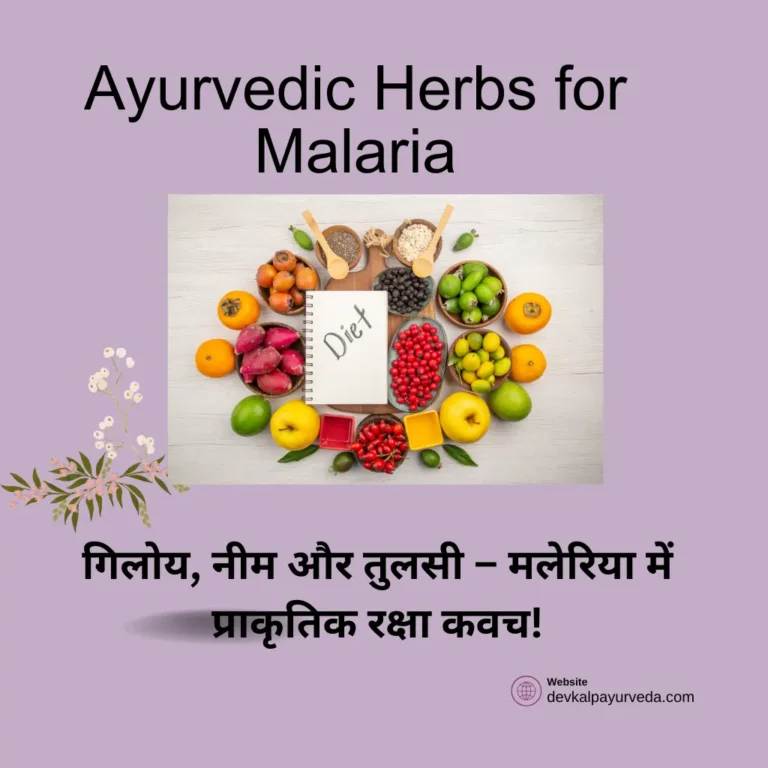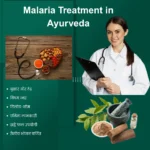Ayurvedic Herbs for Malaria: Natural Remedies for Fever and Immunity
Malaria is a serious infectious disease that continues to affect millions of people globally, especially in tropical and subtropical regions. Caused by Plasmodium parasites transmitted through the bite of infected female Anopheles mosquitoes, malaria can lead to high fever, chills, fatigue, and, in severe cases, life-threatening complications.In Ayurveda, malaria is viewed not just as a parasitic infection but as a systemic imbalance involving the accumulation of toxins (ama), weakened digestive fire (agni), and vitiation of the Pitta and Kapha doshas. Ayurveda emphasizes the body’s natural healing mechanisms, using herbs, diet, and detoxification therapies to restore balance and immunity. This article explores the most effective Ayurvedic herbs for malaria, their actions, benefits, and how they support natural recovery from fever and associated symptoms.
Understanding Malaria in Ayurveda
In Ayurvedic texts, malaria is described as Vishama Jwara, which translates to “irregular fever.” It is typically associated with alternating chills and fever, digestive issues, weakness, and toxin accumulation. The pathogenesis includes:
-
Vitiation of Pitta and Kapha doshas
-
Suppression of Agni (digestive and metabolic fire)
-
Accumulation of Ama (toxic waste from poor digestion)
-
Blockage in bodily channels (srotas)
-
Decreased Ojas (vital energy/immunity)
Rather than targeting just the parasite, Ayurveda aims to cleanse the system, strengthen digestion, balance doshas, and rejuvenate immunity.
Top Ayurvedic Herbs for Malaria
Below are the herbs traditionally used in Ayurveda to manage and recover from malaria and other fevers:
1. Giloy (Tinospora cordifolia)
Ayurvedic Name: Amrita
Dosha Action: Tridosha balancing, especially effective on Pitta and Kapha
Therapeutic Actions:
-
Immunomodulatory
-
Antipyretic (fever-reducing)
-
Antioxidant
-
Hepatoprotective
Relevance in Malaria:
Giloy is one of the most recommended herbs for all types of fevers in Ayurveda. It purifies the blood, improves platelet count, reduces inflammation, and enhances the body’s natural immunity to fight infections like malaria.
Usage:
-
Giloy Juice: 15–20 ml twice a day on an empty stomach
-
Giloy Decoction (Kadha): 10–15 grams of stem boiled in 2 cups of water until reduced to half
-
Giloy Ghanvati Tablets: 1–2 tablets twice daily with warm water
2. Neem (Azadirachta indica)
Ayurvedic Name: Nimba
Dosha Action: Balances Pitta and Kapha
Therapeutic Actions:
-
Antiparasitic
-
Antibacterial
-
Blood purifier
-
Antipyretic
Relevance in Malaria:
Neem helps eliminate parasites from the bloodstream and reduces the toxic load. Its blood-purifying properties make it valuable during high fevers. It also supports liver detoxification.
Usage:
-
Neem Decoction: Boil 10–12 fresh neem leaves in water, reduce to half, and drink once daily
-
Neem Capsules: 500 mg once daily (under supervision)
3. Tulsi (Ocimum sanctum)
Ayurvedic Name: Tulasi
Dosha Action: Balances Vata and Kapha
Therapeutic Actions:
-
Antipyretic
-
Immunomodulatory
-
Antiviral
-
Adaptogenic
Relevance in Malaria:
Tulsi has been used in Ayurvedic fever remedies for centuries. It helps break fever, supports respiratory health, and strengthens immunity against infections.
Usage:
-
Fresh Tulsi Leaves: 5–6 leaves chewed daily
-
Tulsi Tea: Boil the leaves in water, strain, and drink twice daily
-
Juice: 10 ml daily with honey or warm water
4. Kalmegh (Andrographis paniculata)
Ayurvedic Name: Bhunimba
Dosha Action: Primarily Pitta-reducing
Therapeutic Actions:
-
Antipyretic
-
Hepatoprotective
-
Antimicrobial
-
Digestive stimulant
Relevance in Malaria:
Kalmegh is considered one of the most effective bitter herbs in Ayurveda. It is particularly helpful in treating intermittent fevers like malaria. It detoxifies the liver and supports digestion, which is often compromised during fever.
Usage:
-
Kalmegh Powder: 1–3 grams with warm water
-
Capsules/Tablets: As per practitioner’s advice
-
Decoction: Can be prepared using dried herb boiled in water
5. Chirayata (Swertia chirata)
Ayurvedic Name: Kiratatikta
Dosha Action: Reduces Pitta and Kapha
Therapeutic Actions:
-
Antipyretic
-
Bitter tonic
-
Anthelmintic
-
Liver stimulant
Relevance in Malaria:
Chirayata is effective in reducing fever, especially in fevers with periodicity. It also stimulates digestion, cleanses the liver, and aids in the elimination of toxins.
Usage:
-
Decoction: Boil the dried herb in water and consume 30 ml once or twice daily
-
Powder: 1 gram with honey or lukewarm water
6. Papaya Leaf Extract (Complementary)
Though not a classical Ayurvedic herb, papaya leaves are widely used in integrative medicine to support platelet count and immune health.
Therapeutic Actions:
-
Increases platelet production
-
Detoxifies the body
-
Aids in recovery from viral and parasitic infections
Usage:
-
Crush fresh papaya leaves and extract the juice
-
Consume 1–2 tablespoons once or twice daily under guidance
Classical Ayurvedic Formulations for Malaria
Several polyherbal formulations combine these herbs for synergistic action:
1. Sudarshan Churna
A traditional remedy for all types of fevers, made from over 50 herbs including Chirayata, Giloy, and Neem.
-
Action: Antipyretic, digestive, detoxifying
-
Usage: 3–6 grams twice daily with lukewarm water
2. Amritarishta
A fermented liquid preparation containing Giloy and other herbs that improves digestion and strengthens immunity.
-
Usage: 15–20 ml with equal water after meals
3. Triphala Churna
Used to cleanse the gut and improve absorption of other herbal medicines.
How These Herbs Work Together
In Ayurveda, single herbs rarely work in isolation. When combined thoughtfully, they:
-
Break the fever cycle without suppressing symptoms
-
Restore digestion and metabolic fire
-
Purify blood and support liver function
-
Improve energy, reduce weakness, and rejuvenate immunity
-
Prevent relapse by balancing the doshas
Dietary and Lifestyle Tips While Using Ayurvedic Herbs
-
Prefer light, easily digestible meals like moong dal khichdi and vegetable soups
-
Avoid fried, spicy, fermented, and sour foods
-
Stay hydrated with lemon water, herbal teas, and warm fluids
-
Maintain personal hygiene and ensure mosquito protection
-
Take adequate rest and avoid stress or overexertion
Precautions and When to Consult a Physician
-
Always consult a qualified Ayurvedic practitioner before starting herbal medicines, especially in chronic conditions or pregnancy
-
Monitor fever regularly. If symptoms like jaundice, altered consciousness, or extreme fatigue occur, seek immediate medical attention
-
Ayurvedic herbs are generally safe but may interact with other medications. Always inform your healthcare provider of any herbal supplements you take
Conclusion
Ayurvedic herbs offer a time-tested, holistic approach to managing malaria. They work not by targeting the parasite alone but by strengthening the entire system, supporting detoxification, and restoring inner balance. Herbs like Giloy, Neem, Tulsi, Kalmegh, and Chirayata are potent allies in fighting fever naturally and building long-term immunity.
For best results, Ayurvedic herbs should be used as part of a comprehensive healing plan that includes proper diet, lifestyle modifications, detoxification, and rest. When used under expert guidance, they not only help manage malaria but also rejuvenate the body from within.
For a complete understanding of holistic care, read our main post:
Malaria Treatment in Ayurveda: Natural Healing for Fever and Chills


